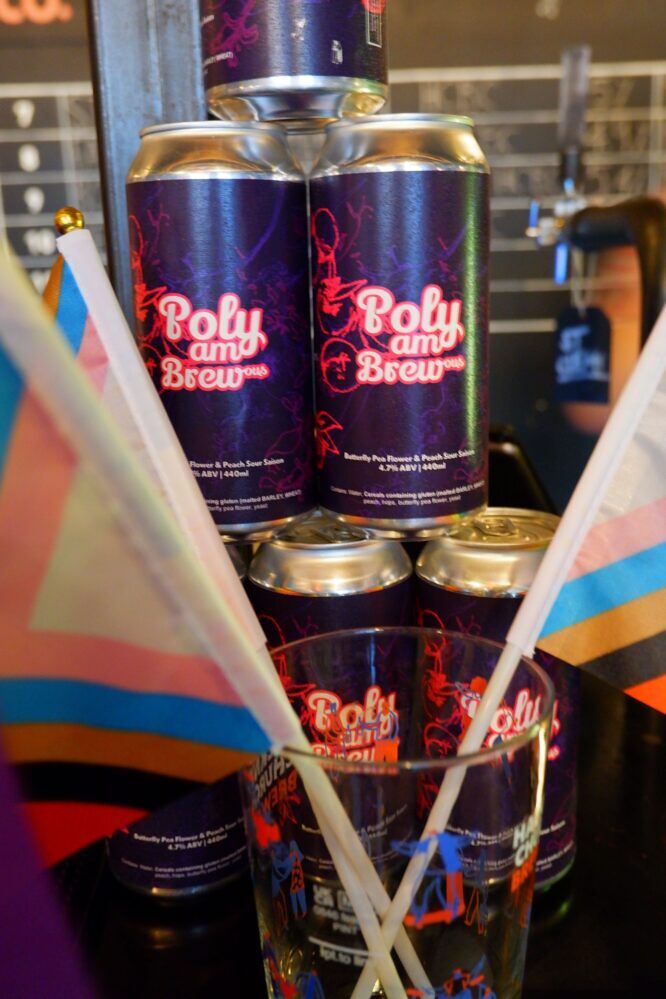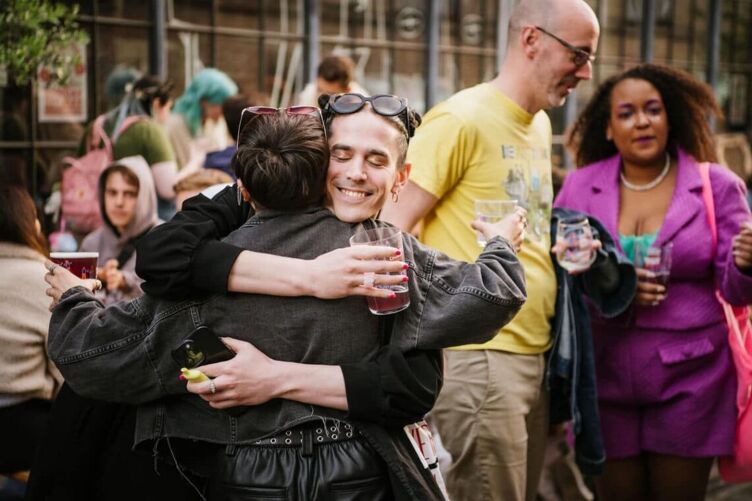The launch party moved me to tears. More members of the polyamorous community turned up than I expected, adorned in glitter, neon, and faux fur. The bright pink and purple posters proudly proclaimed our name from the exposed-brick walls of the dark, post-industrial building, breathing life into the cavernous hetero- and mononormative space.
Pride is a time when many invisible identities become briefly visible. Yet polyamory, considered by many as part of the rainbow, often remains absent from the conversation. Polyamorous people are among the most stigmatized groups in society, but during this year’s Pride month in London, they were welcomed in an unlikely place: the brewery.
Related:
Sesame Street has been celebrating Pride all month long & it is adorable
Sesame Street is standing up for all kids. In response, the LGBTQ community has responded with love for the show and gratitude for the support.
“Polyambrewous,” a butterfly pea flower and peach Saison, is, to my knowledge, the first Queer-Poly Pride beer ever commercially made. It’s a collaboration between Jacob Hobbs, head brewer at Hackney Church Brew Co., and members of the Queer Polyamory Socials London group, including myself. Portions of sales benefit We Exist, a mutual-aid group that financially supports the health and well-being of trans, nonbinary, and intersex people in the U.K.
Never Miss a Beat
Subscribe to our newsletter to stay ahead of the latest LGBTQ+ political news and insights.
“Polyambrewous felt like a project that could acknowledge and affirm the existence and validity of people with diverse relationship structures,” Lxo, a member of the social group who helped lead the project, tells LGBTQ Nation. “It was an important opportunity to create something that members of the London polyamorous communities … could congregate over, feel seen, and be a celebratory part of.”

And there are more of us out there than you think. We are your customers, colleagues, friends, and neighbors; we are your servers and bartenders, insurance agents and lawyers, cheesemongers and farmers-market vendors. You just don’t know it, because it’s not usually safe for us to be visibile.
A 2018 study found that nearly one-fifth (19%) of people in the U.K. and 28% from London and Northern Ireland were polyamorous; meanwhile, poly-oriented dating app Feeld grew 160% from 2019 to 2021. One in nine Americans have been in a non-monogamous relationship — making it almost as common as holding a graduate degree — while one-third say it’s their ideal relationship structure (it was also more common among non-heterosexual respondents).
And that’s just those who feel comfortable enough to self-identify. “We often face challenges related to social stigma, misunderstanding, and marginalization,” Lxo says. “More polyvisibility can counteract these barriers, fostering a climate of acceptance, understanding, and respect.”
What is polyamory?

The word “polyamorous” comes from the Greek and Latin words for “many loves.” Mainstream culture already accepts that we don’t have to choose between loving a partner and loving our parents, friends, and siblings; we love them all in different ways. Yet few concepts are so staunchly opposed — even, sometimes, by other queer people — as non-monogamy.
Society is set up to support couples and nuclear families; everything in popular culture, from romantic comedies to top-10 songs, perpetuates the myth that a lover will complete you. Legal and personal commitments obligate people to stay in relationships with rigid rules even as the relationships change, but in non-monogamous frameworks, staying is a continual choice.
“Most people assume we’re poly because we want to sleep around. It’s usually the opposite,” project participant Juliana D tells LGBTQ Nation. “There are folks who have multiple sexual partners, but it’s also about finding ways to meet needs that maybe you buried or forgot when… trying to make all your needs be met by one person.”
These relationship structures are sometimes called “non-traditional,” yet monogamy contradicts the way humans evolved. For millions of years, people lived in small bands of hunter-gatherers where everything was shared. Sex was a community resource; people had it with whomever they wanted, regardless of gender or relationship structure, and all that oxytocin produced close social bonds. Since nobody could determine fatherhood, men parented all the group’s children together.
It all changed with the adoption of agriculture some 10,000 years ago. When they were always moving, people couldn’t accumulate more than they could carry, so sharing came naturally. But farming created an ownership culture that made everything a commodity, even people. Women and children became property as men claimed paternity so land could be passed along family lines. As the patriarchy rose, individuation reigned and open relationships, along with women and queer folks, were repressed.
Radical consent

Today, popular culture sensationalizes non-monogamous relationship structures as sex-focused and the people who practice them as promiscuous. Yet when approached ethically, they’re frameworks for radical egalitarianism, inclusivity, and consent. And often they don’t involve sex at all (I haven’t so much as gone on a date for more than four years).
“Poly” is often used as shorthand for the broader umbrella of relationship structures it falls under, collectively called Ethical Non-Monogamy (ENM) or Consensual Non-Monogamy (CNM). By definition, polyamory allows for multiple partners and includes subcategories: hierarchical, non-hierarchical, and solo poly. In hierarchical poly, people have “primary” and “secondary” relationships with corresponding rules and priorities, but non-hierarchical poly eliminates these distinctions. Solo polyamory means someone has chosen not to marry or cohabitate, but is open to multiple partners.
ENM also includes relationship anarchy (RA), which states that no relationship is inherently more important than any other; while you may have closer bonds with some, a romantic partner will never take priority over a friend, for example, simply because of who they are. It’s the anti-ownership framework, where love is not a finite resource. Some, like me, claim all of these identities.
Relationships are all about communication, and maintaining multiple, high-priority bonds requires clear and constant dialogue. Far from popular conceptions of love triangles and wife-swapping, everything in ENM revolves around radical consent: Boundaries and expectations for just about everything are defined and stated from the outset, so it’s clear what everyone wants and needs — including where they hope a relationship might lead and their comfort with physical intimacy. Imagine our society if everyone followed poly principles.
When you talk to someone about their partner also having other partners, their first reaction is usually, “I’d be jealous.” But therapist Jessica Fern writes in her book Polysecure that people feel more trusting and less jealous in ENM than in monogamous relationships. Jealousy is a product of ownership culture, the idea that one person having means someone else gets less.
But most people never learn this. Because no one ever asks, and we’re too afraid to speak up. Through Polyambrewous, “I hope people will be curious about polyamory and make space for queer people of all kinds in the beer scene and beyond,” says Juliana. “Visibility is a start, but advocacy and action mean making sure it’s safe and protected to be out.”
Poly-inclusive, not performative

The beer industry doesn’t exactly have a progressive history. Pride brews — where breweries donate part of the proceeds from a special beer to a queer charity — have become more common, first in the U.S. and now the U.K., but they’re often performative gestures: made, consumed, and profited from by straight, cisgender white men without involving any actual queer people.
“I wanted to collaborate… in a way that handed over some of the reins [and really] helped the community,” Hobbs tells LGBTQ Nation, “rather than just slapping a rainbow on a beer can without actually doing anything.”
When Hobbs reached out about creating a Pride brew, it was only after recruiting participants from my circles that I realized everyone was not only queer, but poly, and many were gender-expansive. We saw the opportunity to spotlight our intersecting communities for an audience that, as the name of our charity partner (We Exist) implies, would never have otherwise known about us.
Members of our group participated in almost every aspect of the brew: from choosing the flavor and style to pouring in the grain on brew day to picking a name, planning the party, and designing the can label and poster art, created by Sam Mattacott. Lxo connected us with both the artist and the charity we chose: We Exist will receive £1 from every pint sold in the taproom, plus £10 from kegs and £5 from cases sold to trade. The beer will be available at the brewery and in stores while stock lasts.
Lxo is hopeful Polyambrewous will be a “catalyst for dialogue and understanding… in a relaxed and approachable setting.”
“I don’t know if this beer can get them to challenge their assumptions, but I hope they think about… societal norms and expectations surrounding monogamy as the ‘normal’ relationship model.”
As the sunny afternoon of the launch party yielded to night, a queer DJ blasted anthems while drag performer Nat Funni galloped on a stick pony, the crowd clapping and dancing instead of sequestered in corners, huddled over their pints. It was a glimpse of an alternate future where every part of us was welcome.
“There are more people out there who are some shade of polyamorous, they just don’t have the tools, knowledge, visibility or know-how to step out,” Lxo adds. “I hope more can embrace their polyvisibility sooner without stigma, find their communities faster, [and] celebrate their journeys as soon as possible.”
Don't forget to share:














